child seat CHEVROLET ASTRO 1998 2.G Owners Manual
[x] Cancel search | Manufacturer: CHEVROLET, Model Year: 1998, Model line: ASTRO, Model: CHEVROLET ASTRO 1998 2.GPages: 414, PDF Size: 21.46 MB
Page 8 of 414
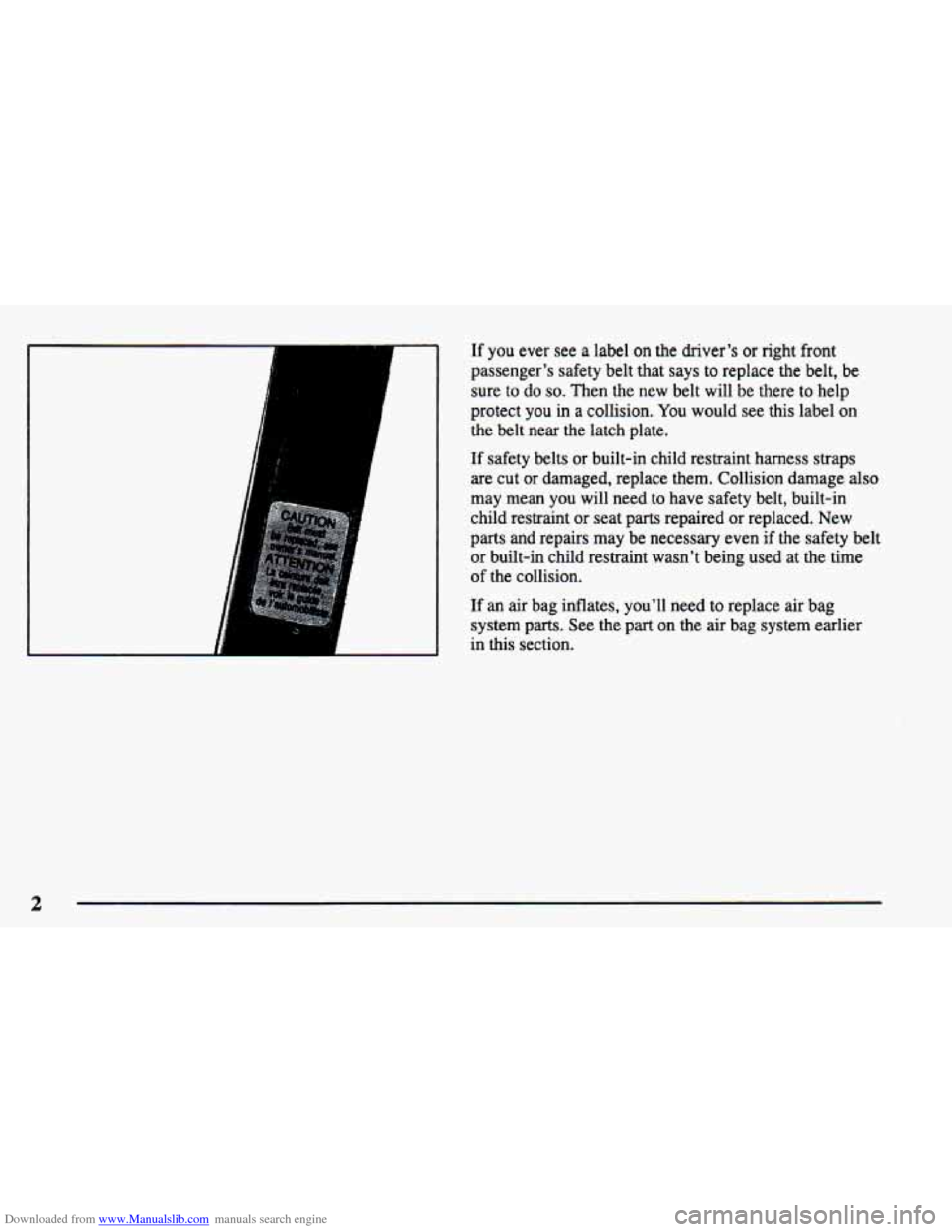
Downloaded from www.Manualslib.com manuals search engine If you ever see a label on the drrver’s or right front
passenger’s safety belt that says to replace
the belt, be
sure
to do so. Then the new belt will be there to help
protect
you in a collision. You would see this label on
the belt near the latch plate.
If safety belts or built-in child restraint harness straps
are cut or damaged, replace them. Collision damage also
may mean you will need to have safety belt, built-in
child restraint or seat parts repaired
or replaced. New
parts and repairs may be necessary even if the safety belt
or built-in child restraint wasn’t being used at the time
of the collision.
If an air bag inflates, you’ll need to replace air bag
system parts. See
the part on the air bag system earlier
in this section.
2
Page 15 of 414
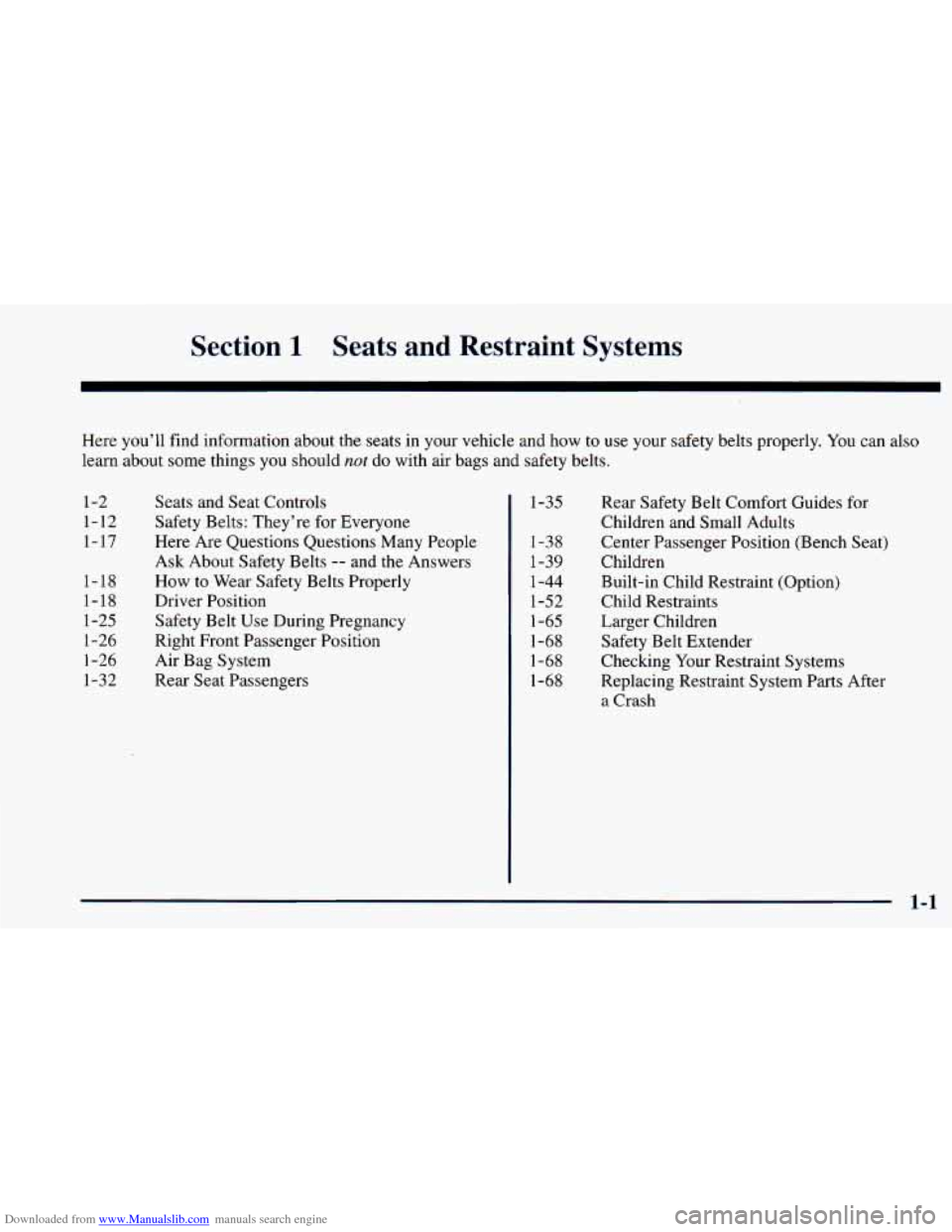
Downloaded from www.Manualslib.com manuals search engine Section 1 Seats and Restraint Systems
Here you’ll find information about the seats in your vehicle and how to use your safety belts properly. You can also
learn about some things you should
not do with air bags and safety belts.
1-2
1-12 1-17
1-18
1-18 1-25
1-26
1-26
1-32 Seats
and Seat Controls
Safety Belts: They’re for Everyone
Here Are Questions Questions Many People
Ask About Safety Belts
-- and the Answers
How to Wear Safety Belts Properly
Driver Position
Safety Belt Use During Pregnancy
Right Front Passenger Position
Air Bag System
Rear Seat Passengers 1-35
1-38 1-39
1-44
1-52
1-65
1-68
1-68
1-68 Rear
Safety Belt Comfort Guides for
Children and Small Adults
Center Passenger Position (Bench Seat)
Children
Built-in Child Restraint (Option)
Child Restraints
Larger Children
Safety Belt Extender
Checking Your Restraint Systems
Replacing Restraint System Parts After
a Crash
Page 22 of 414
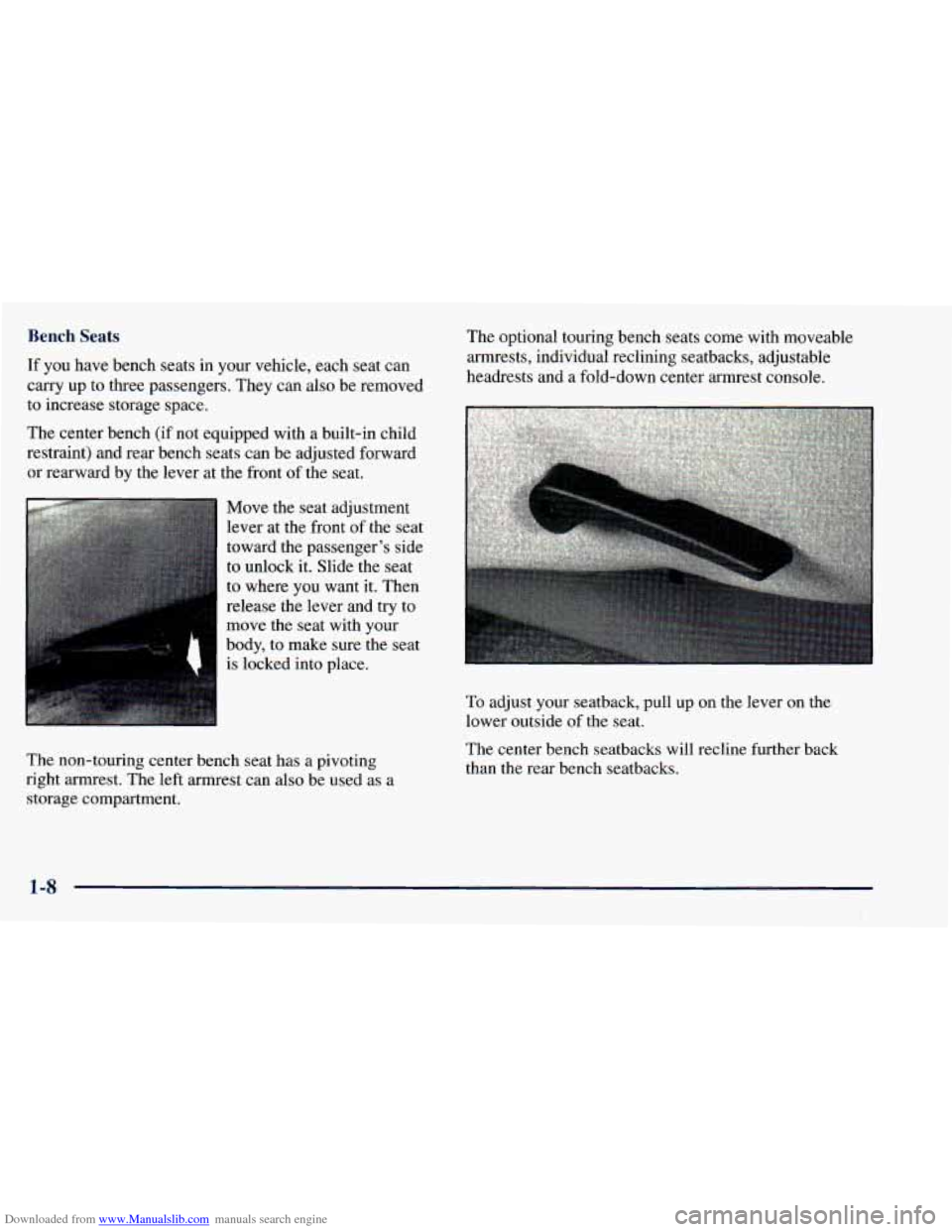
Downloaded from www.Manualslib.com manuals search engine Bench Seats
If you have bench seats in your vehicle, each seat can
carry up to three passengers. They can also be removed
to increase storage space.
The center bench (if not equipped with a built-in child
restraint) and rear bench seats can be adjusted forward
or rearward by the lever at the front of the seat.
Move the seat adjustment
lever at the front
of the seat
toward the passenger’s side
to unlock it. Slide the seat
to where you want it. Then
release the lever and try to
move the seat with
your
body, to make sure the seat
is locked into place. The
optional touring bench seats come with moveable
armrests, individual reclining seatbacks, adjustable
headrests and
a fold-down center armrest console.
The non-touring center bench seat has a pivoting
right armrest. The left armrest can also be used as a
storage compartment. To
adjust your seatback, pull up on the lever on the
lower outside of the seat.
The center bench seatbacks will recline further back
than the rear bench seatbacks.
1-8
Page 32 of 414
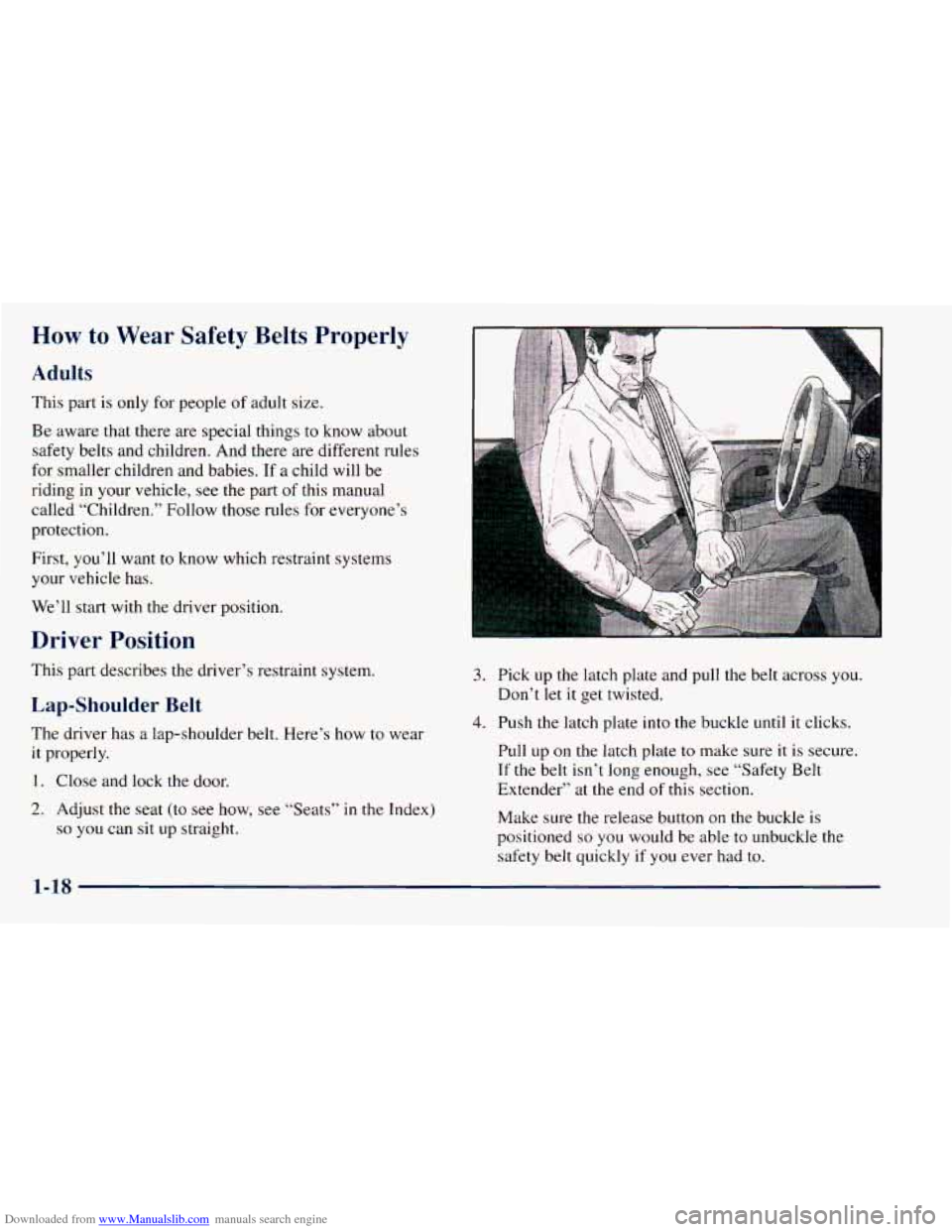
Downloaded from www.Manualslib.com manuals search engine How to Wear Safety Belts Properly
Adults
This part is only for people of adult size.
Be aware that there are special things to know about
safety belts and children. And there are different rules
for smaller children and babies. If
a child will be
riding in your vehicle, see the part of this manual
called “Children.” Follow those rules for everyone’s
protection.
First, you’ll want
to know which restraint systems
your vehicle has.
We’ll start with the driver position.
Driver Position
This part describes the driver’s restraint system.
Lap-Shoulder Belt
The driver has a lap-shoulder belt. Here’s how to wear
it properly.
1. Close and lock the door.
2. Adjust the seat (to see how, see “Seats” in the Index)
so you can sit up straight.
3. Pick up the latch plate and pull the belt across you.
4. Push the latch plate into the buckle until it clicks.
Don’t
let it get twisted.
Pull up
on the latch plate to make sure it is secure.
If the belt isn’t long enough, see “Safety Belt
Extender” at the end
of this section.
Make sure the release button
on the buckle is
positioned
so you would be able to unbuckle the
safety belt quickly if you ever had to.
1-18
Page 49 of 414
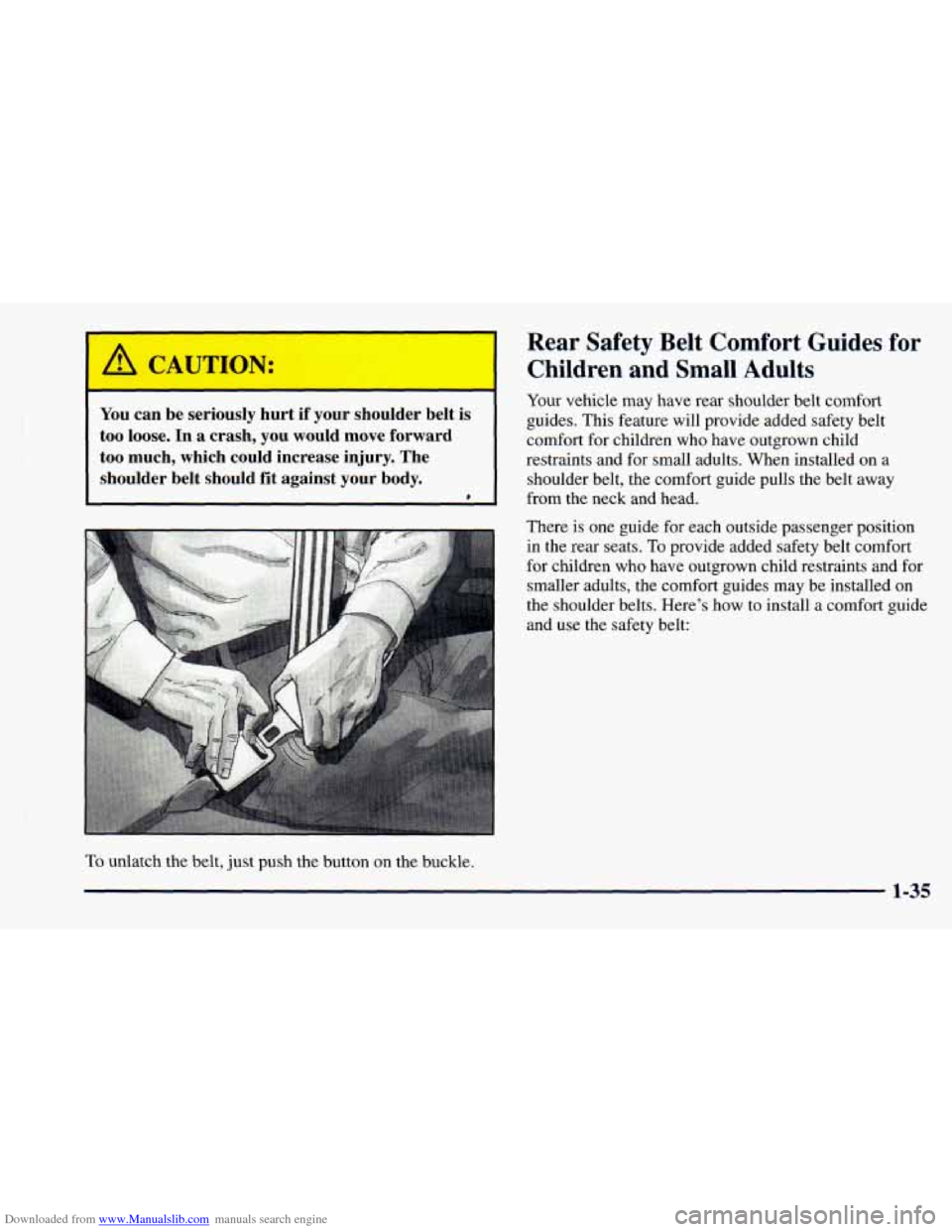
Downloaded from www.Manualslib.com manuals search engine 1 A CAUTION:
r
You can be seriously hurt if your shoulder belt is
too loose. In a crash, you would move forward
too much, which could increase injury. The
shoulder belt should fit against your body.
1
To unlatch the belt, just push the button on the buckle.
Rear Safety Belt Comfort Guides for
Children and Small Adults
Your vehicle may have rear shoulder belt comfort
guides. This feature will provide added safety belt
comfort for children who have outgrown child
restraints and for small adults. When installed on a
shoulder belt, the comfort guide pulls the belt away
from the neck and head.
There
is one guide for each outside passenger position
in the rear seats.
To provide added safety belt comfort
for children who have outgrown child restraints and for
smaller adults, the comfort guides may be installed on
the shoulder belts. Here's how to install a comfort guide
and use the safety belt:
1-35
Page 58 of 414
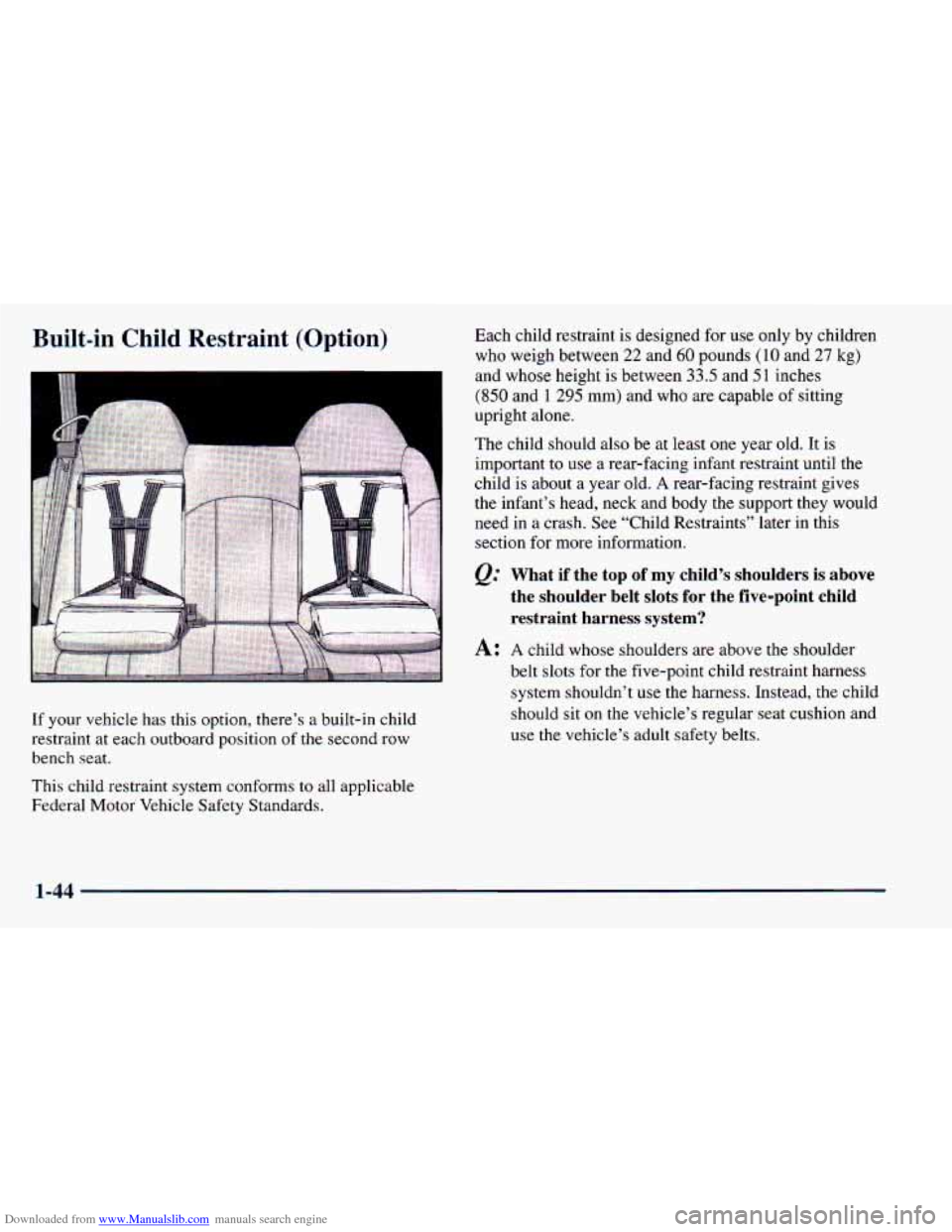
Downloaded from www.Manualslib.com manuals search engine Built-in Child Restraint (Option)
e
If your vehicle has this option, there’s a built-in child
restraint at each outboard position of the second row
bench seat.
This child restraint system conforms
to all applicable
Federal Motor Vehicle Safety Standards. Each
child restraint is designed for use only by children
who weigh between 22 and
60 pounds (10 and 27 kg)
and whose height is between 33.5 and
5 1 inches
(850 and
1 295 mm) and who are capable of sitting
upright alone.
The child should
also be at least one year old. It is
important to use a rear-facing infant restraint until the
child is about a year old. A rear-facing restraint gives
the infant’s head, neck and body the support they would
need in
a crash. See “Child Restraints” later in this
section for more information.
@ What if the top of my child’s shoulders is above
the shoulder belt slots for the five-point child
restraint harness system?
A: A child whose shoulders are above the shoulder
belt slots for the five-point child restraint harness
system shouldn’t use the harness. Instead, the child
should sit
on the vehicle’s regular seat cushion and
use the vehicle’s adult safety belts.
1-44
Page 60 of 414
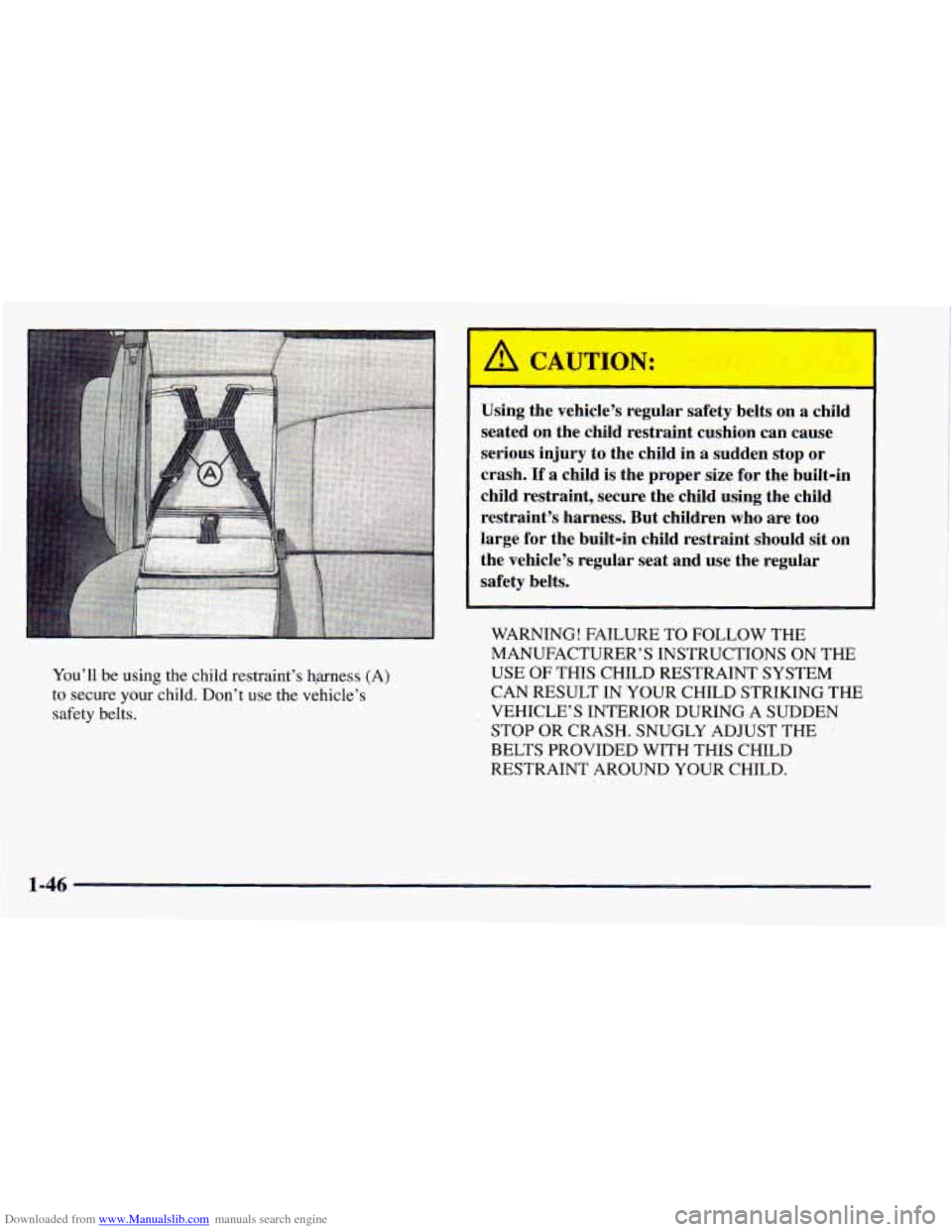
Downloaded from www.Manualslib.com manuals search engine You’ll be using the child restraint’s hg-ness (A)
to secure your child. Don’t use the vehicle’s
safety belts.
I
Using the vehicle’s regular safety belts on a child
seated on the child restraint cushion can cause
serious injury to the child in a sudden stop or
crash.
If a child is the proper size for the built-in
child restraint, secure the child using the child restraint’s harness, But children who are too
large for the built-in child restraint should
sit on
the vehicle’s regular seat and use the regular
safety belts.
WARNING! FAILURE TO FOLLOW THE
MANUFACTURER’S INSTRUCTIONS ON THE
USE
OF THIS CHILD RESTRAINT SYSTEM
CAN RESULT IN YOUR CHILD STRIKING THE
VEHICLE’S INTERIOR DURING A SUDDEN
BELTS PROVIDED WITH THIS CHILD
RESTRAINT AROUND YOUR CHILD.
STOP
OR CRASH. SNUGLY ADJUST THE
1-46
Page 64 of 414
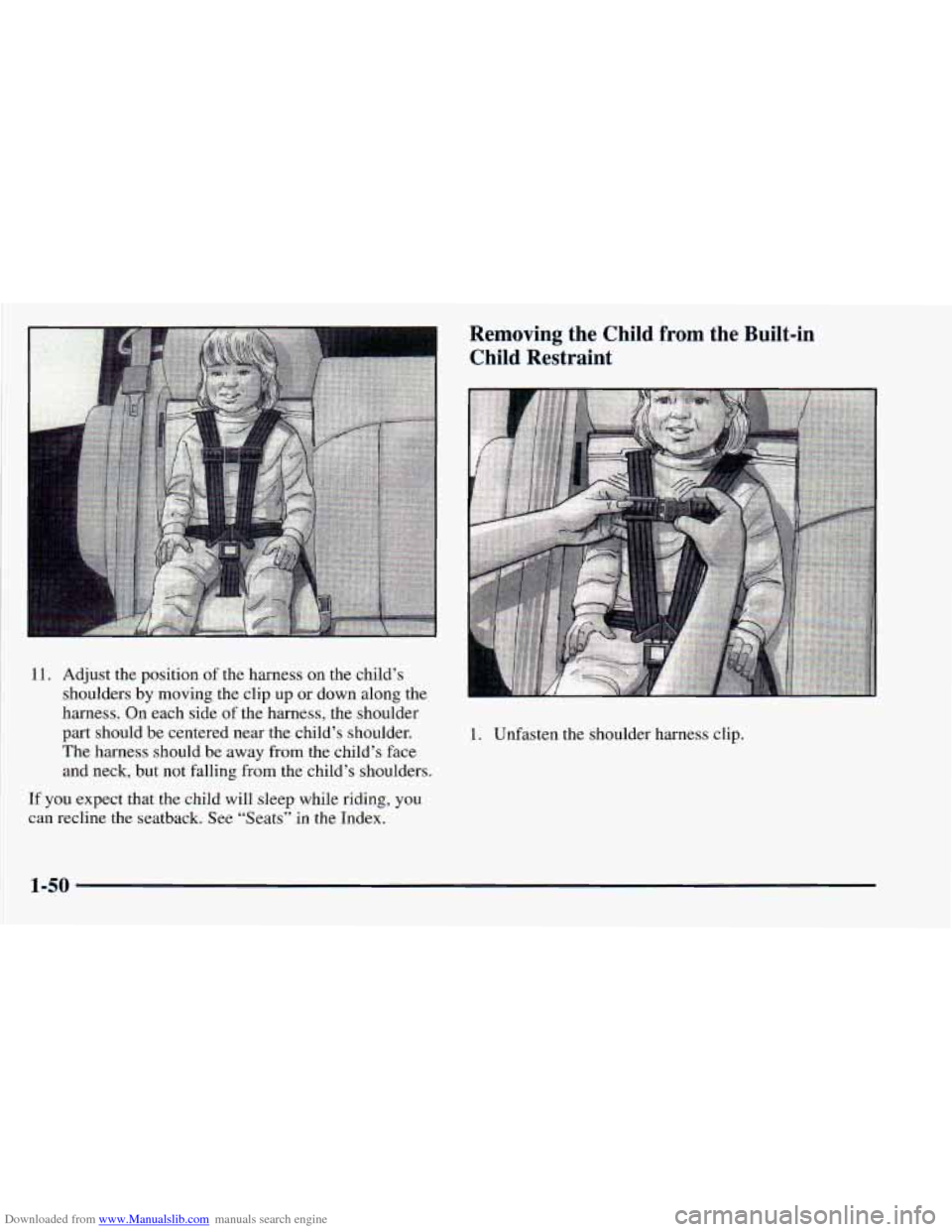
Downloaded from www.Manualslib.com manuals search engine Removing the Child trom the Built-in Child Restraint
11. Adjust the position of the harness on the child’s
shoulders by moving the clip up or down along the
harness. On each side
of the harness, the shoulder
part should be centered near the child’s shoulder.
The harness should be away from the child’s face
and neck, but not falling from the child’s shoulders.
If you expect that the child will sleep while riding, you
can recline the seatback. See “Seats” in the Index.
1. Unfasten the shoulder harness clip.
1-50
Page 65 of 414
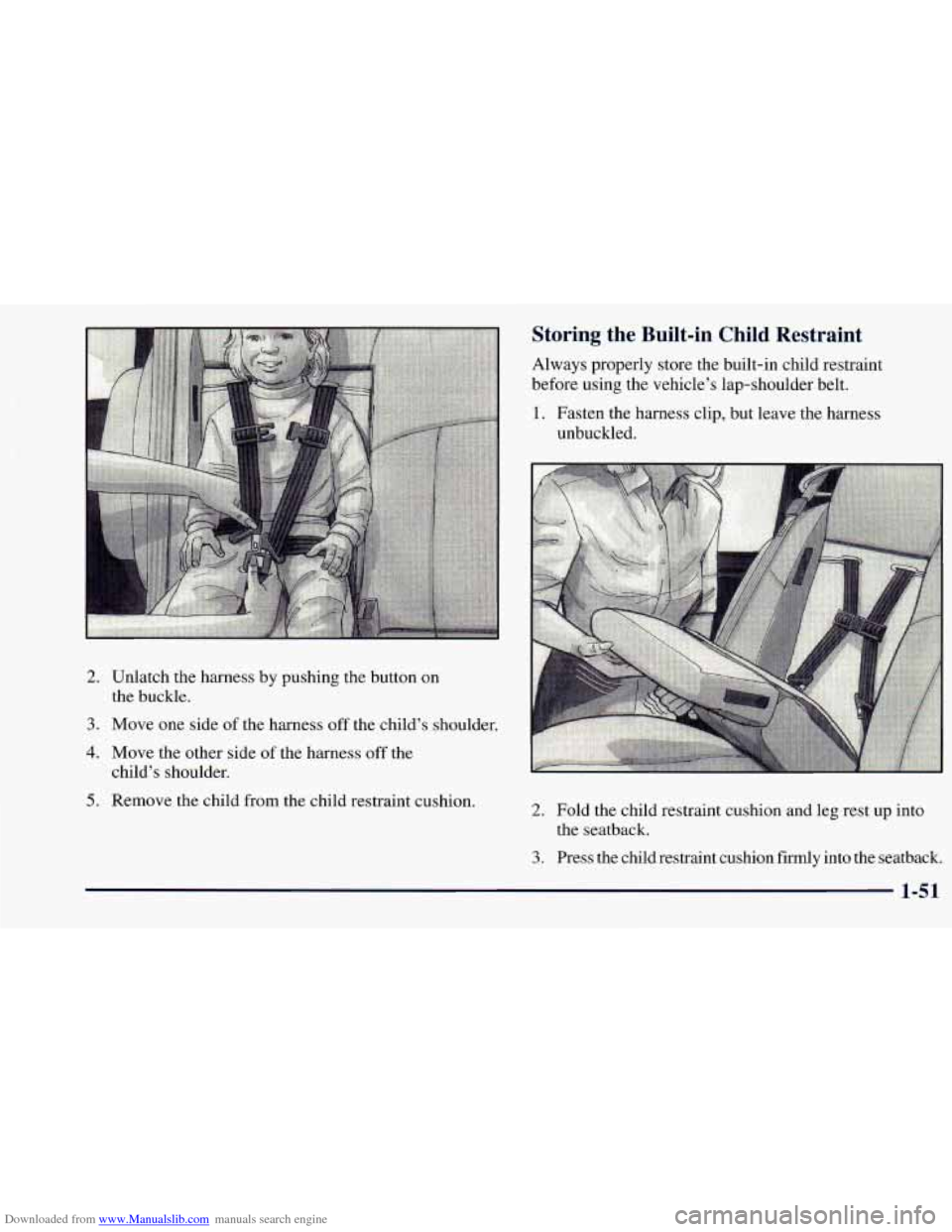
Downloaded from www.Manualslib.com manuals search engine 2. Unlatch the harness by pushing the button on
the buckle.
3. Move one side of the harness off the child's shoulder.
4. Move the other side of the harness off the
child's shoulder.
5. Remove the child from the child restraint cushion.
Storing the Built-in Child Restraint
Always properly store the built-in child restraint
before using the vehicle's lap-shoulder belt.
1. Fasten the harness clip, but leave the harness
unbuckled.
2. Fold the child restraint cushion and leg rest up into
the seatback.
3. Press the child restraint cushion firmly into the seatback.
Page 66 of 414
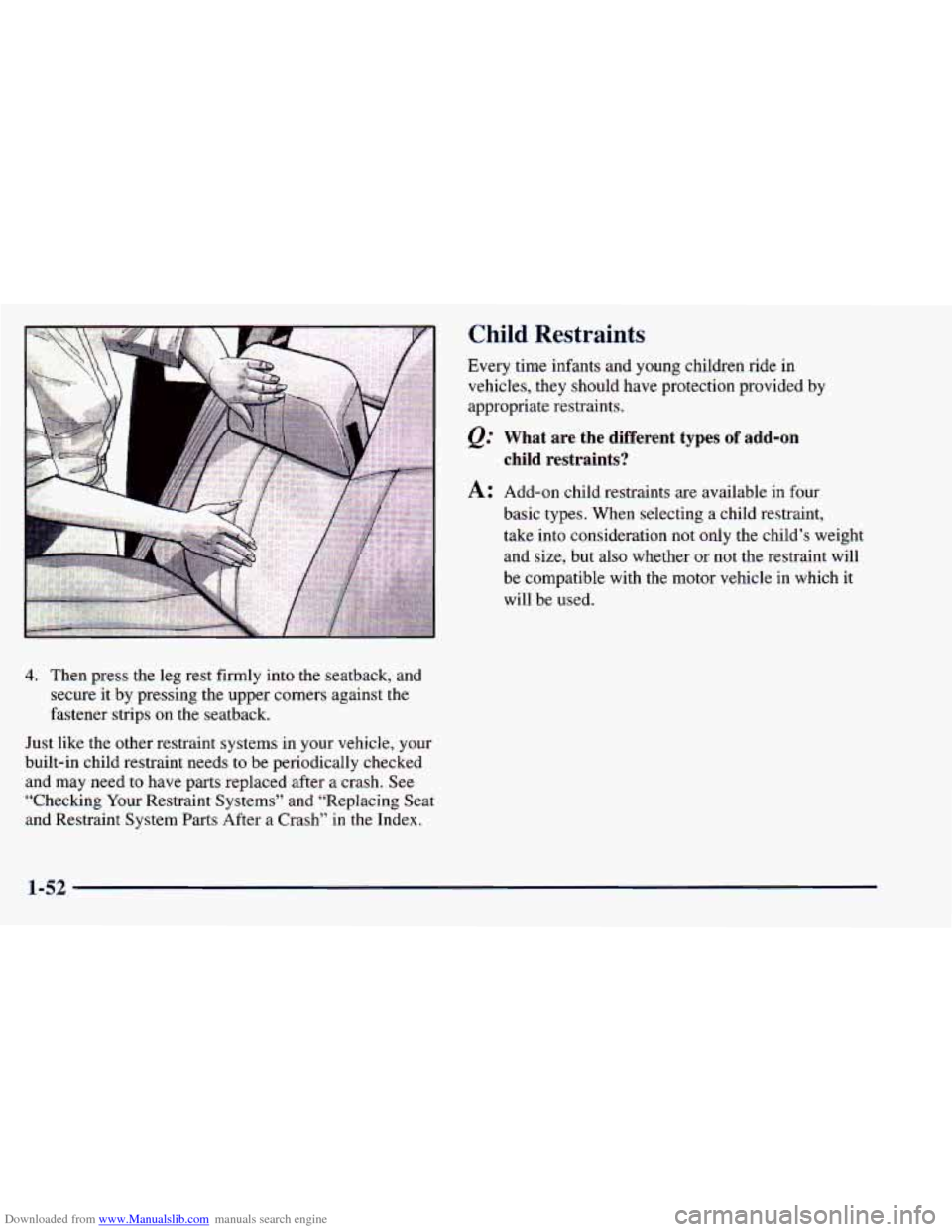
Downloaded from www.Manualslib.com manuals search engine 4. Then press the leg rest firmly into the seatback, and secure it by pressing the upper corners against the
fastener strips on the seatback.
Just like the other restraint systems in your vehicle, your
built-in child restraint needs to be periodically checked
and may need to have parts replaced after
a crash. See
“Checking Your Restraint Systems” and “Replacing Seat
and Restraint System
Parts After a Crash” in the Index.
Child Restraints
Every time infants and young children ride in
vehicles, they should have protection provided by
appropriate restraints.
@ What are the different types of add-on
A: Add-on child restraints are available in four
basic types. When selecting a child restraint,
take into consideration not only the child’s weight
and size, but also whether or not the restraint will
be compatible with the motor vehicle in which it
will be used.
child restraints?
1-52